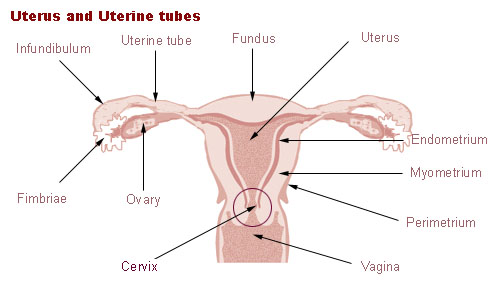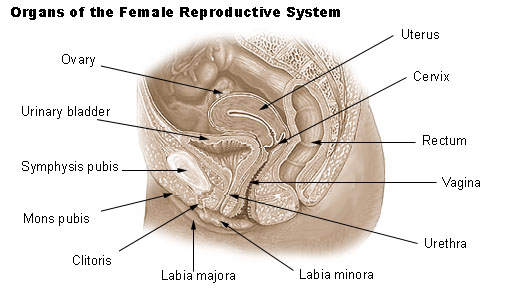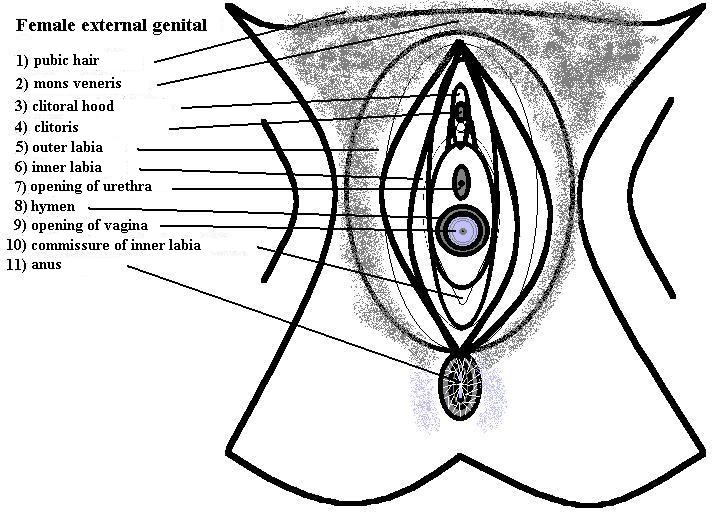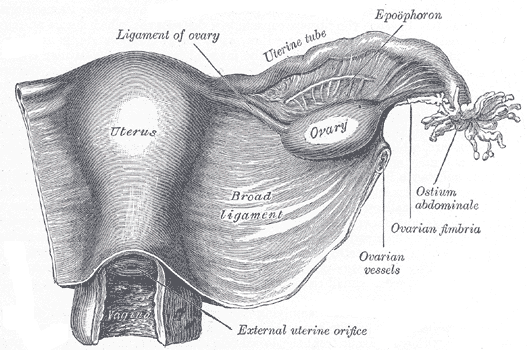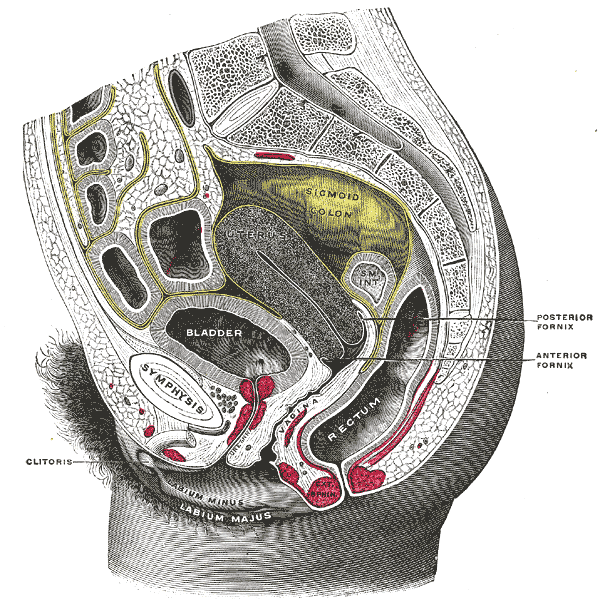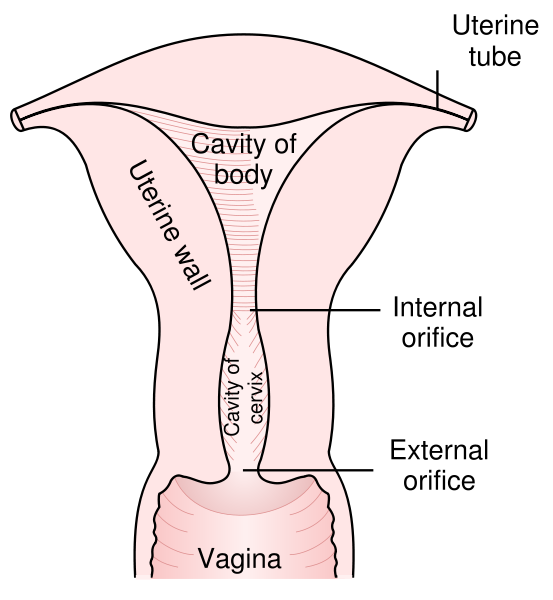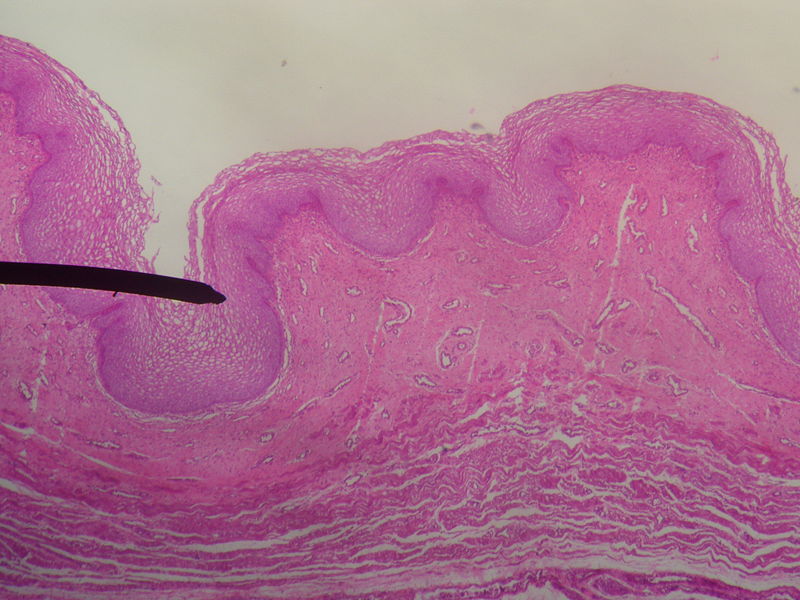Vagina
The vagina, (from Latin, literally "sheath" or "scabbard" ) is the cylinder tubular tract leading from the uterus to the exterior of the body in female placental mammals and marsupials, or to the cloaca in female birds, monotremes, and some reptiles. Female insects and other invertebrates also have a vagina, which is the terminal part of the oviduct. The Latinate plural (rarely used in English) is vaginae.
In common speech, the term "vagina" is often used inaccurately to refer to the vulva or female genitals generally; strictly speaking, the vagina is a specific internal structure and the vulva is the exterior genitalia only.
Human anatomy
The human vagina is an elastic muscular canal that extends from the cervix to the vulva.[1] Although there is wide anatomical variation the average vagina is 6 to 7 inches (15 to 18 cm) in length; its elasticity allows it to stretch during sexual intercourse and during birth to offspring.[2][3] The vagina connects the superficial vulva to the cervix of the deep uterus.
If the woman stands upright, the vaginal tube points in an upward-backward direction and forms an angle of slightly more than 45 degrees with the uterus. The vaginal opening is at the caudal end of the vulva, behind the opening of the urethra. Above the vagina is Mons Veneris. The vagina, along with the inside of the vulva, is reddish pink in color, as with most healthy internal mucous membranes in mammals.
Vaginal lubrication is provided by the Bartholin's glands near the vaginal opening and the cervix. The membrane of the vaginal wall also produces moisture, although it does not contain any glands. Before and during ovulation, the cervix produces cervical mucus, which provides a favorable environment for sperm to survive.
The hymen is a membrane which is situated at the opening of the vagina. As with many female animals, the hymen covers the opening of the vagina from birth until it is ruptured during activity. The hymen may rupture during sexual or non-sexual activity; the presence or absence of a hymen does not indicate prior sexual activity.
Biological functions of the vagina
The vagina has several biological functions.
Menstruation
The vagina provides a path for menstrual blood and tissue to leave the body. In modern societies, tampons, menstrual cups, and sanitary towels may be used to absorb or capture these fluids.
Sexual activity
The concentration of the nerve endings that lie close to the entrance of a woman's vagina can provide pleasurable sensation during sexual activity, when stimulated in a way that the particular woman enjoys. During sexual arousal and particularly stimulation of the clitoris, the walls of the vagina self-lubricate, reducing friction during sexual activity.
An erogenous zone referred to commonly as the G-spot is located at the anterior wall of the vagina, about five centimeters in from the entrance. Some women experience intense pleasure if the G-spot is stimulated appropriately during sexual activity. A G-Spot orgasm may be responsible for female ejaculation, leading some doctors and researchers to believe that G-spot pleasure comes from the Skene's glands, a female homologue of the prostate, rather than any particular spot on the vaginal wall.[4][5][6] Some researchers deny the existence of the G-spot.[7]
Childbirth
During childbirth, the vagina provides the route to deliver the baby from the uterus to its independent life outside the body of the mother. During birth, the vagina is often referred to as the birth canal. The vagina is remarkably elastic and stretches to many times its normal diameter during vaginal birth.
Sexual health and hygiene
The vagina is self-cleansing and therefore usually needs no special treatment. Since a healthy vagina is colonized by a mutually symbiotic flora of microorganisms that protect its host from disease-causing microbes, any attempt to upset this balance may cause many undesirable outcomes, including abnormal discharge and yeast infection. The acidity of a healthy vagina due to lactic acid secreted by symbiotic microorganisms retards the growth of many strains of dangerous microbes.
The vagina is examined during gynecological exams, often using a speculum, which holds the vagina open for visual inspection of the cervix or taking of samples (see pap smear).
Signs of Vaginal Disease
Vaginal Diseases present with lumps, discharge and sores.
- Lumps:[8]
The presence of unusual lumps in the wall or base of the vagina is always abnormal. The most common of these is Bartholin's cyst. The cyst, which can feel like a pea, is formed by a blockage in glands which normally supply the opening of the vagina. This condition is easily treated with minor surgery or silver nitrate. Other less common causes of small lumps or vesicles are herpes simplex. They are usually multiple and very painful with a clear fluid leaving a crust. They may be associated with generalized swelling and are very tender. Lumps associated with cancer of the vaginal wall are very rare and the average age of onset is seventy years[9]. The most common form is squamous cell carcinoma, then cancer of the glands or adenocarcinoma and finally, and even more rarely, melanoma.
- Discharge:[10]
The great majority of vaginal discharges are normal or physiological and include blood or menses (from the uterus), the most common, and clear fluid either as a result of sexual arousal or secretions from the cervix. Other noninfective causes include dermatitis, discharge from foreign bodies such as retained tampons or foreign bodies inserted by curious children. Non-sexually transmitted discharges occur from bacterial vaginosis and thrush or candidiasis. The final group of discharges include sexually transmitted diseases, gonorrhoea, Chlamydia and Trichomonas. The discharge from thrush is slightly pungent and white, that from Trichomonas more foul and greenish and that from foreign bodies resembles the discharge of gonorrhea, greyish or yellow and purulent (like pus).
- Sores[11]
All sores involve a break down in the walls of the fine membrane of the vaginal wall. The most common of these are abrasions and small ulcers caused by trauma. While these can be inflicted during rape most are actually caused by excessive rubbing from clothing or improper insertion of a sanitary tampon. The typical ulcer or sore caused by syphilis is painless with raised edges. These are often undetected because they occur mostly inside the vagina. The sores of herpes which occur with vesicles are extremely tender and may cause such swelling that passing urine is difficult. In the developing world a group of parasitic diseases also cause vaginal ulceration such as Leishmaniasis but these are rarely encountered in the West. HIV/AIDS can be contracted through the vagina during intercourse but is not associated with any local vaginal or vulval disease[12]. All the above local vulvovaginal diseases are easily treated. Often only shame prevents patients from presenting for treatment[13]
Additional images
-
Uterus and uterine tubes.
-
Organs of the female reproductive system.
-
Schematic vulva anatomy.
-
Uterus and right broad ligament, seen from behind.
-
Sagittal section of the lower part of a female trunk, right segment.
-
Posterior half of uterus and upper part of vagina.
-
Layers of the vaginal wall.
See also
References
- ↑ http://www.womenshealth.gov/glossary/#vagina http://www.womenshealth.gov/glossary/#vagina] Womenshealth.gov
- ↑ http://www.medterms.com/script/main/art.asp?articlekey=5951 Medterms.com
- ↑ http://www.metrokc.gov/HEALTH/famplan/flash/grades11-12/G1112-L17.pdf Metrokc.gov
- ↑ Crooks, R. Our Sexuality. California: Brooks/Cole. Unknown parameter
|coauthors=ignored (help) - ↑ Jannini E, Simonelli C, Lenzi A (2002). "Sexological approach to ejaculatory dysfunction". Int J Androl. 25 (6): 317–23. PMID 12406363.
- ↑ Jannini E, Simonelli C, Lenzi A (2002). "Disorders of ejaculation". J Endocrinol Invest. 25 (11): 1006–19. PMID 12553564.
- ↑ Hines, T (2001). "The G-Spot: A modern gynecologic myth". Am J Obstet Gynecol. 185 (2): 359–62. Unknown parameter
|month=ignored (help) - ↑ Mayo Clinic Staff Bartholin’s Cyst. January 19 2008 accessed http://www.mayoclinic.com/health/bartholin-cyst/DS00667/DSECTION=1 23 March 2008
- ↑ Manetta A, et al Primary invasive carcinoma of the vagina. Obstet Gynecol. 1988 Jul;72(1):77-81.
- ↑ Spence D, Melville C,. Vaginal Discharge. BMJ 2007;335:1147-1151 (1 December)
- ↑ Micali G, Benign Vulval Lesions. eMedicine Dec 4 2006 accessed at http://www.emedicine.com/med/fulltopic/topic3295.htm#section~AuthorsandEditors 23rd March 2008.
- ↑ Mayo Clinic Staff HIV/AIDS. January 20 2008 accessed at https://www.mayoclinic.com/health/hiv-aids/DS00005 on 23rd March
- ↑ Butcher J ABC of Sexual Health: Female Sexual Problems 11: Sexual Pain and Sexual Fears. BMJ 1999;318:110-112 ( 9 January )
nan:Im-tō af:Vagina ar:مهبل az:Uşaqlıq yolu bg:Влагалище ca:Vagina cs:Pochva cy:Gwain da:Skede (kønsorgan) pdc:Dasche de:Vagina eo:Vagino fa:مهبل gd:Faighean gl:Vaxina hr:Vagina ilo:Uki id:Vagina iu:ᐅᑦᓱᒃ/utsuk it:Vagina ku:Vajîna he:נרתיק lt:Makštis (lytinis organas) jbo:vibna ml:യോനി nl:Vagina no:Vagina nn:Vagina qu:Rakha simple:Vagina sk:Pošva (vagína) sl:Nožnica sr:Вагина su:Liang Heunceut fi:Emätin sv:Slida tl:Puke ta:யோனி th:ช่องคลอด uk:Піхва yi:וועזשינע zh-yue:陰道
